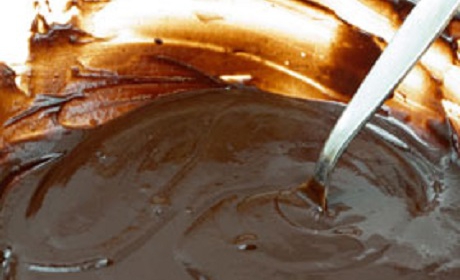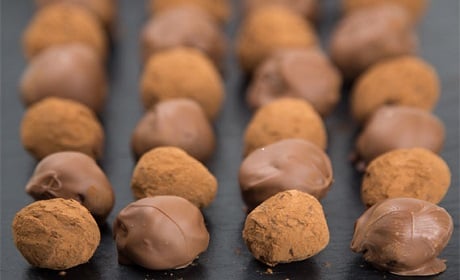This little indulgence takes less than an hour to make and you can play around with different coatings, mixtures and toppings.
Summary
Makes: 30 to 40 truffles
Preparation: 30 minutes
Cooking: 20 minutes
Total: 50 minutes (plus 20 minutes to cool)
Ingredients
200g dark chocolate (70 percent cocoa)
45g butter, cut into small cubes
60g crystallised (candied) ginger
1 orange, zest only
180g double (heavy) cream
70g ight muscovado sugar
a pinch of sea salt
300g milk chocolate, broken into squares
2 tbsp cocoa powder, sifted
Method
1. Cut the dark chocolate into very small pieces and add the diced butter. Put in a large heat proof bowl.
2. Cut the crystallised ginger into small cubes and add the orange zest. Put it into another heat proof bowl.
3. Heat the cream and sugar together over a medium heat stirring continuously until it comes to the boil. Allow to simmer for a minute, then remove from the heat and leave to cool for a couple of minutes.
4. Pour the cream and sugar mixture on to the chocolate and butter, then stir with a fork until smooth. Add a pinch of salt and stir again.

Mixture of cream, sugar with chocolate and butter. Photo: John Duxbury
5. Pour half the mixture on to the ginger and orange and stir to mix.
6. Allow both mixtures to cool, then cover and refrigerate for about an hour until set, but not too hard.
7. Use a teaspoon to scoop out the truffle mixture, then mould/roll it by hand into balls. Return your truffles to the fridge to keep cold.
8. Put 200g of the milk chocolate into a heatproof bowl over, but not touching a pan of simmering water and allow to melt. Remove the bowl from the heat and add the rest of the chocolate. Stir with a fork until evenly mixed and all the chocolate has melted.
9. Sieve the cocoa powder on to a plate.
10. When the temperature of the milk chocolate reaches 33°C (91°F), dip each of the plain truffles into the milk chocolate and using two teaspoons roll them around to coat them and then transfer them on to a piece of greaseproof paper to set.
11. Repeat step 10 for the ginger and orange truffles but immediately after coating with the milk chocolate roll them in the cocoa mixture, using another couple of teaspoons. Once evenly coated transfer them on to a piece of grease proof paper to set.
Tips
• Although you could make a smaller number of truffles than recommended here, we think it is better to make a large batch and freeze some for a later date.
• If you make two types and freeze them, make a note on the box to say which have been dusted with cocoa powder.
• The ideal temperature for the milk chocolate coating in step 10 is 31°C, but we have suggested 33°C to give you time to coat all the truffles. If the chocolate is too hot it will be too runny and if it gets too cold it will be too thick and sticky to coat the truffles well. Also, if the chocolate is too hot it will bloom and so the truffles will not look as nice. One of the reasons that many chocolate truffle recipes use a coating of cocoa powder, sugar or chopped nuts is to hide any bloom!



 Please whitelist us to continue reading.
Please whitelist us to continue reading.